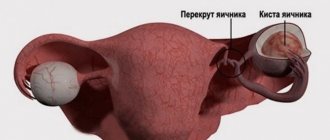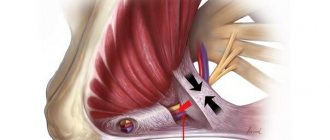To understand why hysteria initially occurs in both men and women can only be understood by delving into the physiological aspects of the problem.
Anyone who believes that a man cannot have a uterus is greatly mistaken - he does! True, the male uterus - a small cavity in the prostate that opens into the lumen of the urethra - cannot be called a full-fledged organ - it is not intended for receiving and bearing a fetus. However, the fact is irrefutable.
Actually, how do male genital organs differ from female genitals? The fact that in the process of intrauterine sexual differentiation, either the cavernous bodies of the penis or the labia are formed from the same rudiments, while the other part becomes either the prostate or the uterus.
Both of these organs are not only muscle formations, but also glandular ones. This means that they are hormonally active, largely determining the general hormonal background, creating not only the image, but also the entire philosophy of our life.
Since the need to obtain food has long ceased, and one doesn’t really want to reproduce, most of human energy has now gone into the psycho-emotional sphere - into the “production and redistribution” of the energy of emotions (for now - through “showdowns” in household, industrial and national contexts).
A man who used to carry a doe killed during a hunt into a house on his shoulders now strives to sneak out of this house, spending most of his time hunting in the wilds of the Internet, at a stadium or in a beer pub, posing as a football fan.
And the woman, who has ceased to be a reaper and washerwoman, tries hard to somehow keep this “slippery, cowardly and lazy male” next to her.
Why does she need this, clean and well-fed? The modern woman - like her primitive predecessor - is not only still filled with the fire of primitive unspent sexual power, but is also equally engulfed in the flame of unbridled passions and desires.
Only this power is still astral-emotional - it is still powerless to do at least something in this world of matter without the participation of a man. But since a man is in no hurry to voluntarily realize a woman’s many desires, she simply very skillfully “extracts” it from him.
Not by washing (whining), but by rolling (including rolling on the floor in hysterical fits on the verge of blackout).
And the uterus is “to blame” for this, having lost the meaning of life and lost its rhythm in the modern world, alien to its nature.
The uterus pulsates with a certain (variable) frequency, in a passionate desire for motherhood-pregnancy, trying to attract to itself the “beating” male prostate in one with it and extract the coveted seed from it. But, having not received what she wanted, in her righteous anger she distorts the woman’s life so much that it changes her psyche beyond recognition.
Hence the popular name for hysteria in women: uterine rabies.
But how then can we explain the man’s hysteria?
By the same mechanism: his brain and psyche, tired of “unweaving” the ingenious “lace” of female passions or struggling in their snares, put into action the male “uterus” - the prostate.
It protects its owner from female “terror” through “anti-terrorism,” powerfully activating the production of “hormones of anger, fear and despair.” Externally, the process manifests itself as a fit of male rage on the verge of rage.
Powerless rage, because what can a modest-sized male uterus do against all the power of a massive female one? And that’s why the man almost always gives in. Or runs away (including dying).
“Yes, sir, such a neurosis!”
Contrary to the generally accepted opinion that hysterical neurosis is simply a form of female bitchiness, the categorical conclusion of medical science should be cited: hysteria is one of the varieties of neurosis, because it does not have any organic substrate (if this is not the case, it is no longer hysteria).
It has long been noticed: this pathology is burdened with natures that are overly impressionable, refined, “airy”, “fluttering in the clouds” of daydreaming - and absolutely cut off from sinful earthly life with all its dirt and mold.
Raised with copious tears and sighs from novels and movies, these “muslin young ladies” are simply unable to endure the touch of rough, materially dense life, the slightest breath of it simply knocks them off their feet - there is no need to talk about direct coercion and violence at all.
For these are, for the most part, individuals raised under the gaze of a whole series of generations of similarly educated women - mothers and grandmothers - who are ready to run for a thermometer or an enema at the slightest change in the “princess’s” facial features.
Accustomed to their own, “innate” weakness, “sickness” and helplessness, living with an eye on who to lean on (more precisely, who to hang on), people of this type never live their own lives - their heads are full of other people’s, operetta-like ideas about what as it should be ideally.
And these ideas are so strong and resourcefully tenacious that the hysteric becomes a real despot, imposing them on everyone around him - whoever dares to offend a fragile “porcelain doll”, it is better to give in. As a person grows up, she gets used to believing that it simply cannot be any other way.
And this fragile butterfly (and a tenacious leech rolled into one) is brought into life, where you have to somehow act and say something. What to do if your legs can’t hold you up?
Yes, just falling into the arms of the first suitable compassionate representative of the opposite sex - your head is spinning, they say! She was really dizzy, and for good reason.
After all, these naive dreamers never have any idea of their own about specific everyday affairs - the “drive belts” of life; they are worried and frightened even by the very prospect of having them. Their credo is “yes, but...”. And this, said in a weak voice in which tears tremble, “but” categorically excludes the possibility for them to do anything on their own.
Having fallen into someone else's heartily open arms, hysterical people remain in them for the rest of their lives - they are “too weak” to walk on their own feet.
Having settled comfortably in a quiet, “windless” place, a fragile butterfly can bring offspring - and after that don’t say a word to it at all: I am for you, not sparing myself, and you...! Or something similar. But this comfort is purely external, because in the head of such a cut personality there is real soda.
What to do
The instructions include several steps.
Interception attempt
To avoid hysteria, you need to:
- Study the precursors (they are individual for everyone).
- Be able to recognize an approaching attack in advance.
- Urgently distract, switch attention to something exciting, interesting.
As distractions, you can use bright books, favorite toys, pets, watching what is happening on the street, looking for goodies in the kitchen, etc. Parents know their baby better and should be aware of what might really interest him. The technique is effective only if the hysteria has not yet begun. It is useless to use it during an attack.
Problem Identification
When the child calms down, it is necessary to find out the cause of his disorder and, having clearly formulated, talk about the problem that has arisen. For example: “You’re angry because I didn’t buy you a doll,” “You’re offended because you weren’t allowed to go out for a walk yet.” First, it will allow him to realize what happened. Secondly, it will teach you to talk about your own feelings.
After this, an explanatory conversation is held about why he did not get what he wanted: “We agreed that we would buy a doll for his birthday,” “We still need to have dinner, wash and play - we wouldn’t have time to do all this if we stayed for a walk.”
Such open, confidential conversations bring children closer to their parents, contribute to the establishment of closer contact, teach them to think logically and be aware of the presence of limiting boundaries that cannot be crossed under any circumstances.
Not everything will work out the first time - at first the child will argue and defend his rights, but gradually realizes the futility of such rebellions and his own wrongness.
Keeping Calm
If you couldn’t prevent the approaching thunderstorm, you can try to stop your child’s hysteria by following these instructions:
- Do not prove anything to him, do not explain, do not educate him, since at this moment he is not able to adequately perceive speech and communicate normally.
- Do not raise your voice under any circumstances.
- Do not use physical force: pulling the arm, shaking, slapping the butt, slapping the head - this will only worsen the situation.
- Do not regret, do not panic that he is in pain (due to the lack of motor control, pain is not felt).
While remaining calm, you need to lean towards the child or sit down in front of him so that your eyes are at his level (in no case should you communicate from top to bottom while hanging over him). In an even, peaceful voice, quietly say the key phrase: “I understand that you are offended, but you can’t behave like that.” She kills several birds with one stone:
- you show him your involvement: you understand him;
- you formulate the problem, helping him to realize his own emotion (resentment);
- remind you of the rules of behavior that should already be instilled.
The peaceful tone of voice and emotional equanimity of an adult should also have a calming effect. If you manage to capture attention, a hug and a kiss on the cheek will help you finally cope with a child’s hysteria. If educational measures were taken before, such actions on the part of an adult will be enough to stop the attack. But what to do if you couldn’t stop it?
Ignoring
If the hysteria continues despite all your actions, the only correct way out of the current situation is to ignore it. This is the most difficult thing for parents. After all, it seems to them that:
- The child is about to have a heart attack, he is screaming so hard;
- he will break and scratch his head and hands until they bleed;
- everyone looks at him and judges him;
- it will never end.
These thoughts need to be discarded. It’s easy to cope with such a panicky mood if you make sure once that a child’s hysteria does not lead to serious consequences (a heart attack or a concussion). Abrasions on the arms and forehead will go away quickly. As for those around you, if everything happens in a public place, think about the fact that you are seeing all these people for the first and last time, so their opinion does not matter. If there is someone you know among them, you can quietly apologize to him. An adequate person will understand that this happens to many people in childhood.
As soon as the child understands that the hysteria had no effect and the adult remained indifferent, he will stop screaming and hitting the floor. When a means to achieve a goal turns out to be useless, he needs to look for a replacement, which he will do, thinking over a new plan.
Attention! The behavior of an adult requires adjustment if the hysteria occurred in a public place where:
- a huge number of people, a tightly packed crowd (in public transport, for example);
- there are old people, disabled people, other small children, pregnant women next to you;
- silence is required (at a performance).
You need to understand that in such situations the child interferes with others and may even accidentally harm them (kick, bite, hit, scratch). The adult’s task is to prevent this from happening and take him away or urgently distract him. The most effective maneuver is the effect of a sudden switch of attention: “Wow! Look who's flying in the sky! Over there! Don't you see? Don’t know who it is?”, “Oh, where did your scarf go? I definitely remember you wearing it! Where could he have disappeared to? You know?". But keep in mind: every time you need to come up with something new. Children are unlikely to fall for the same trick twice.
Summarizing
After the hysteria ends, you should not immediately start scolding the child, educating him, or expressing your displeasure. You need to wait some time. At the same time, try to pay minimal attention to it. But don’t ignore if he asks something and tries, as they say, to build bridges. Be sure to answer, but in monosyllables, reluctantly, demonstrating with your appearance that you are unhappy with what happened.
Psychologists recommend waiting a pause of 15 minutes after a hysteria. If it drags on, it will be useless to talk: short-term memory is responsible for children’s emotions, so 20-30 minutes after the incident they may not remember why it happened and what exactly they are to blame for. It also makes no sense to start a conversation earlier, since the resentment and dissatisfaction will still be too fresh and everything could happen again.
First, the problem is identified and formulated: “You are offended / angry / upset because...”. This technique was described in detail above for stopping hysteria at the initial stage.
After this, it is necessary to draw the child’s attention to the consequences of the hysteria he threw:
- “Look: you scratched your hands / hurt your forehead.”
- “You really scared the girl who was standing next to you.”
- "You made me sad".
- “What you did is bad - you can’t behave like that, you and I have already talked about this. Therefore, you will have to be punished."
He must understand that this cannot be done. Don’t be afraid to punish for tantrums - the carrot and stick system gives its results in education. Of course, this should not be physical violence or deprivation of a walk (= fresh air). What is allowed:
- place for 5-7 minutes (depending on age) in a corner;
- leave him alone for a while to think about his behavior (if there are adults in adjacent rooms);
- deprive of sweets;
- replace your phone (tablet/TV) with a book with an instructive tale;
- go to bed earlier.
If a child learns exactly why he is being punished, believe me, next time he will think carefully before throwing another tantrum.
What's going on inside the hysterical person?
It is impossible to say that those suffering from hysteria are absolutely and serenely happy. For this is a constant state of intense anticipation of some kind of trouble, tragedy and cataclysm of any scale, which is extremely exhausting for them personally and for everyone around them. The psyche of the sufferer (or sufferer) is full of fears and all sorts of obsessive thoughts that cannot be escaped.
The essence of this personality type is eternal panic when thinking not even about tomorrow, but about the day that has already arrived and the current one, in which something can happen. And if (suddenly!) nothing happens, so much the worse; an accomplished drama is better than foggy uncertainty. “Drama” can mean anything from missing hair clips to an alleged Martian invasion.
An attempt to work or serve for those suffering from hysteria ends disastrously: eternal stay “on sick leave” makes the employee undesirable to the enterprise and leads to dismissal. Which further strengthens the belief in one’s absolutely exceptional morbidity and absolute helplessness.
Illnesses are generally a separate “playing field” for the hysterical. The tense anticipation of troubles cannot but lead to some changes in health, and now it has happened! - the illness struck. A thorough analysis of it and comparison with what is “in the medical reference book” instantly leads to the conclusion about a serious or even incurable disease.
And if there is also a truly sick person in the family or someone has recently died... For the hysterical, the only possible conclusion arises: of course, I will be next (next).
Diseases. The indispensable and heaviest “brick in the wall”, which fences off the hysterical person from the world.
But about the extreme manifestations of hysteria, special mention should be made.
Causes of hysterics in women
Considering the changeable nature of the female character, any representative of the fairer sex is, to one degree or another, prone to hysterical manifestations under conditions conducive to this. However, there are a number of main reasons why a lady’s psycho-emotional state can be greatly shaken in an instant.
- Susceptibility to chronic overfatigue - due to the huge burden of responsibility towards the family and children, tension accumulates, and a nervous breakdown acts as a “release”, allowing the woman to relieve excessive fatigue.
— Wrong diet - following fashion trends for a thin, over-dried body from diets leads to the fact that a woman denies herself a nutritious diet filled with fats and carbohydrates in the required volume, due to which the nervous system does not receive proper support, expressing dissatisfaction with the malfunction.
- Lack of a competent approach to time planning - while doing many things in a day, the fair sex often forgets the importance of taking a minute for herself to relax, refresh her body and mind, which leads to outbreaks of aggression.
— Irregularity of intimate life – acting as a psychological boost, intimacy with a partner helps maintain emotional balance at the proper level, and long-term abstinence has a negative impact on mood.
Knowing the main points responsible for the appearance of a hysterical state, you can plan your actions in such a way as to prevent the occurrence of an advanced case.
Soon, soon will the gravestone hide my chest?
A woman who always wants to be the one and only, but experiences terrible inner uncertainty in this world of gross matter, tries to attract the attention of a male support through hysterical behavior in the form of theatricality and affectation, excessively loud laughter, ridiculous haircut and hair color, inventing himself with various fables and other ostentatious antics.
But when these techniques do not work, the last trump card is used in the form of a hysterical attack.
With all her appearance, the woman screams: here I am, and I desperately need help!!! She screams literally, piercingly loud.
It screams so that the face turns purple and the veins on the head swell, and the mouth becomes distorted, while the body makes the most wild and unbridled movements, no longer subject to the will of the mistress: it falls to the floor, rolls around on it, arching, beating with its legs and arms, scratching its face and pulls out hair.
For the consciousness of the owner of the body is darkened - it is not here now, but in the twilight zone, and only pain or a bucket of ice water dousing the body can bring it back from there.
Hysteria in women is most often accompanied by imitation of disorders of the central nervous system, the symptoms of which appear:
- neurogenic blindness, deafness, vomiting, suffocation (simulating an asthmatic attack);
- pain in the heart (like angina);
- pseudoparalysis and pseudoparesis.
Everything is “pseudo”, because with the end of the seizure, body functions are completely restored. But memories of what recently happened to the body and consciousness are not preserved.
Not only lonely, sexually unsatisfied women, but also completely legitimate husbands and wives can suffer from hysterical attacks.
A physiological (due to excess estrogen in the blood) reason for a seizure may be:
- long-term sexual abstinence;
- a certain phase of the menstrual cycle;
- pregnancy;
- menopause;
- chronic alcohol or drug intoxication;
- overstrain of the brain and body, languishing from idleness;
- excess coffee “got to the head” or the consequences of a very specific cranial injury;
- stress both in the family and at work.
The problems are not just yesterday, but have been accumulating for years. And now, finally, they have found a way out in such desperately uncontrollable, often public behavior, which brings colossal relief.
A relief that will soon require repeating. This means that a continuation is coming “in the next episode.” Or depression and even a suicide attempt from the realization of what has been done (for not all religions and cultures allow such “unbridled” behavior). And the very movements of a body uncontrolled by the mind can lead to its death, just like during an epileptic seizure.
This is the answer to the question: what is the danger of hysteria specifically for the body (for the manipulation of the consciousness of family members in this case is obvious and does not need comment).
In addition, there is a direct threat to the psyche of a patient with hysteria - he sinks more and more into the swamp of self-pity and the search for more and more new diseases and symptoms, dooming himself to increasingly desperate loneliness in the circle of those who previously loved him and who judge him and treat him with irritation and anger .
Additional recommendations
If a child is hysterical, this is the first signal to parents to change their attitude towards him, their education system and their daily routine. What measures will help:
- Maintaining a daily routine.
- Ensuring proper, healthy nutrition in an age-appropriate manner.
- Sports activities.
- Adequate rest without overwork.
- Respectful attitude starting from a very young age.
- Allocating sufficient time for games, walks, leisure, and favorite activities.
- Allows you to show independence (in extreme cases, you can then re-tie your shoelaces and wash the plate).
- Provide the right to choose (wear a yellow or blue T-shirt, go for a walk with your mother or grandmother).
- Organize a calm atmosphere before bed (if he falls asleep hysterically).
Do not deviate from the education system. Among all adults in the family, its main points must be agreed upon. If it is not allowed to sit in front of the TV after ten in the evening, then neither grandparents nor anyone else should violate this rule. The moments at which a child is deprived of the right to choose should be:
- clearly and correctly formulated: it is advisable to avoid the words “must” and “impossible” - they act like a red rag on a bull, but the pronoun “we” is welcome;
- voiced;
- pronounced in a firm voice that does not tolerate argument, but not rudely or harshly;
- constant: they must be regularly repeated in the same wording every time the corresponding situation arises.
For example: “We’re eating porridge,” “Let’s go home,” “We’ll buy it next time,” etc. Every time a child hears such phrases, he will form behavioral patterns that parents need. He must understand that at such moments it is useless to argue and hysteria. This idea needs to be instilled in him constantly. At first, of course, he will protest, but soon he will learn the rules and will treat restrictions, rules and requirements more calmly.
Entrance is open, and not only for women
Not only women, but also men and children unconsciously resort to hysteria as a way to almost instantly get rid of accumulated mental ballast.
But if a child’s hysteria has one meaning: finally notice me - and love me for who I am - then in men it is different and means: leave me alone!
Both categories can respond to mental pressure with sleep and appetite disorders, headaches and loss of strength.
A very young child often wakes up at night with hysterics, falls to the floor crying, knocking his legs and arms, hitting his head on the floor.
But in men, hysteria also has the following symptoms:
- sexual weakness or impotence;
- pseudocardiac and pseudogastric pain;
- causeless suffocation and suppression;
- paleness (redness) of the face with sweat on the skin;
- tremors in the hands, tics and other neurotic manifestations of stress.
Eloquently saying: you “got me”! “Pseudo” means that all changes occurring in the body pass without a trace along with the disappearance of reasons for psychological stress.
Why does hysteria happen?
Not every person experiences hysteria. This explosion of emotions is characteristic, as a rule, of creative and excitable people. Hysteria occurs to release tension. Usually it accumulates for quite a long time. A person maintains external calm for a long time and behaves adequately. And then one day a breakdown occurs and hysteria begins.
The cause of hysteria can be a contradiction between the desire for something and the inability to satisfy it. This is especially pronounced in young children. After all, at an early age they still do not know how to control their desires.
Sometimes hysteria can be caused by an unexpected strong experience, which happens in difficult life circumstances. Often from one’s own powerlessness and inability to change anything.
Is hysteria real or fake?
Hysteroepilepsia, or the debut of an epileptic disease with hysterical seizures, is otherwise called imitation hysteria and is often classified as a neurosis of childhood in children with epilepsy, complicating diagnosis and delaying treatment of the true cause of hysterical reactions.
Hysterical manifestations with imitation of seizures and true epilepsy occurring in adults are frequent.
What is the difference between a hysterical and epileptic seizure?
This:
- the absence in a hysterical seizure of a clearly defined clonic and tonic stage typical of an epileptic one;
- emphasized unconscious posing with pretentious movements and facial expressions (with particular agitation in crowded places) and preservation of pain and pupillary reactions during hysteria;
- a neurological “trail” often remaining after a hysterical attack in the form of spastic and flaccid paralysis, paresis, contractures, aphonia, manifestations of astasia-abasia, as well as anuria (or polyuria), belching, hiccups, tachycardia, which is unusual for an epileptic seizure;
- completion of an epileptic seizure with sleep or bodily-motor agitation, oligophasia (absent during a hysterical attack).
However, “unraveling the tangled braid” from a combination of epileptic and hysterical symptoms can be extremely difficult. And here instrumental diagnostics in the form of an EEG come to the rescue, making it possible to detect both changes in electrical activity unusual for hysteria, and the epileptogenic foci themselves.
If you were nearby?
People around are also able to help a person who is beginning to “explode”. The main thing is to act correctly.
We need to redirect his attention. An effective way is with a slap. However, here you need to be very careful and act based on the specific situation and personality of the person. You should treat the situation calmly and not get angry. This has a calming effect on someone who is hysterical. In some cases, the method of “response aggression” can help someone.
At the same time, the person observing the hysteria should try to portray an attack. Such false hysteria distracts attention, and the person quickly calms down. It happens that the situation is too unpleasant and you can barely restrain yourself. In this case, you can use the “Chinese mirror” method. Repeat after the screamer all his actions. Your task is to show him how he looks from the outside when he behaves like this. This especially helps with children. The child quickly calms down and looks at you with curiosity. During an emotional outburst, try to prevent the person from harming themselves and others.
If you see that he is close to inappropriate actions, you need to intervene: to protect yourself and the “hysterical” person. Remove dangerous and heavy objects from his field of vision - knives, forks, screwdrivers, figurines.
If the rebel is light in weight, you can take him to the bathroom and put him under the shower. Or apply cold to his temples - ice, frozen berries or fruits. Splash cold water on your face. Cooling down not only provides an opportunity to take your mind off what is happening. It slows down reactions and therefore holds back emotions.
If a tantrum occurs with a small child at home, then this option comes to the rescue: the child screams, and you hit yourself.
By doing so, you are showing how hurt his behavior is to you. Usually the child is surprised at the first moment, and then rushes to feel sorry for you.
Sedation and “lying down”, or the treatment of seizures
Treatment of hysteria and hysterical neurosis should be comprehensive and include the use of psychotropic drugs, psychotherapy, restoratives, and physical therapy methods; Spa treatment courses are useful.
With the development of neurotic states, especially those accompanied by affective (including depressive) disorders that cannot be treated on an outpatient basis, “lying down” is indicated - hospitalization in the department of a psychiatric hospital for “calm neurotics”.
The arsenal of drug therapy for hysteria includes the use of tranquilizers, the best effect of which is obtained by dosed, hourly use per os:
- Diazepam – Seduxen, Oxazepam – Tazepam, Chlordiazepoxide – Elenium from 10 to 30 mg/day;
- Phenazepam from 1 to 3 mg/day;
- Meprotane – Meprobamate from 200 to 800 mg/day.
What to do in case of massive hysteria?
In case of persistent obsessions, massive hysterical disorders, intramuscular and, in case of inpatient care, intravenous drip administration of tranquilizers (Diazepam, Chlordiazepoxide) or connection to therapy with small doses of antipsychotics are justified:
- Etaperazine from 4 to 12 mg/day;
- Chlorprothixene from 15 to 50 mg/day;
- Thioridazine – Melleril from 10 to 50 mg/day;
- Neuleptil – Propericiazine from 10 to 20 mg/day.
Or the use of drugs with a prolonged period of action - Fluorophenazine-decanoate (Moditen-depot) from 12.5 to 25 mg 1 time/2 weeks.
Patients with predominant manifestations of asthenia are effectively treated with a combination of tranquilizer-Piracetam (Nootropil) or tranquilizer-Aminalon.
The severity of affective (depressive) disorders requires a combination of a tranquilizer and antidepressant (Amitriptyline with Chlordiazepoxide and the like).
Cases with persistent sleep disturbance are treated with Nitrazepam (Eunoctin, Radedorm) from 5 to 15 mg, Phenazepam from 0.5 to 1.5 mg, Teralen from 5 to 10 mg, Chlorprothixene 15 mg.
What to do if a 2-3 year old child is hysterical - advice from a psychologist:
Dr. Komarovsky has his own view on children's hysteria:
How to prevent the development of hysteria
First of all, it is necessary to shift the emphasis in life from the patient’s ego, which is painfully inflated by excessive attention, to other, no less important aspects of existence. It is necessary that the child being raised is as open to the world as possible and finds his rightful place in it, and does not languish in anxious loneliness on a “pedestal” that is inaccessible in height for him to be able to jump onto it.
Any suggestion of exclusivity, pain, or helplessness should be excluded from verbal communication and the customs and traditions of the family. It should be taken into account that this process is not quick, often requiring the re-education of several generations of the parents themselves.
When preparing a child for independent life, it is worth resolving the issue of rational professional guidance with the possibility of eliminating occupational hazards in the form of additional neuroticization of the individual at work.
Everything must be done so that the individual can believe that he is capable of life without the care of parents and patrons.
And for this, she needs to be unobtrusively but demandingly encouraged to take the first few independent steps as early as possible. For any journey begins with standing on your own feet. And, as Tsiolkovsky once aptly said on another occasion, “you can’t live forever in a cradle.”
Causes of hysterics
Hysteria is never completely causeless; it always becomes a reaction to certain stimuli. It is not always immediately obvious what exactly caused the child’s behavior, but the task of parents is to understand this and work with specific problems. If hysterical attacks are not caused by neurological or mental disorders, then in most cases the following causes of children's hysterics can be identified:
Lack of parental attention
The child needs contact with his parents. He wants to communicate and spend time together. The baby needs to know that he is loved and that he is important to his parents. If a child lacks attention, he will look for ways to get it at any cost. Sometimes tears, screams and an exaggerated reaction are almost the only opportunity for a little person to remind himself of himself, to try to get adults to notice him, even if this attention is with a minus sign. Therefore, tantrums are often a reason to wonder whether the child has enough interaction with you, whether he feels abandoned and deprived.
Physical discomfort
When the baby is tired, wants to eat or drink, when he is hot or, conversely, too cold, unpleasant sensations and overwork can cause hysterics. Such reactions are especially typical for children 1-2 years old, when the child is not always fully aware of the needs of his body. In this situation, it is difficult to overestimate the importance of the daily routine. Regular times for meals, walks and sleep, lack of excessive activity before putting the child to bed, attention to the physical condition of the baby - all this can help strengthen the nervous system and, as a result, significantly reduce the number of tantrums.
Inability to express thoughts and feelings verbally
This is a common cause of tantrums in children under 3 years of age. The child is overwhelmed with emotions, he wants to convey something to you, craves understanding and response. The baby does not know how to express what he feels, and this irritates him and causes outbursts of anger. The situation can be complicated if it is generally not customary in the family to talk about feelings. It is very important that from a very early age parents teach their child to verbally express emotions. Help the baby - ask him if he is angry, scared or excited, show that you, for your part, sincerely want to understand his feelings.
Crisis due to age
A short but violent period of hysterics may be associated with the so-called crisis of three years. At this age, children go through an important stage of growing up, and this moment is usually accompanied by strong emotional reactions. The child strives for independence, is stubborn, probes the boundaries, and tries to “push” the parents. This is a normal stage of development, and the main thing at this moment is to remain calm and not succumb to the child’s provocations. Don't let him manipulate you, otherwise the child will remember that this is an effective way to get his way and will use it regularly. There is no need to ignore more active manifestations of character than before or to put pressure on parental authority, but it is necessary to let the child understand what is good and what is bad, and not to push the boundaries of what is permitted at the slightest request.
Inconsistency of parents
When the demands of adults on a child are unsystematic and illogical, and in some cases contradict each other, his confusion and misunderstanding find an outlet in hysterics. From the very beginning, you should develop clear rules and restrictions and follow them. Do not scold your child today for what was a reason for praise yesterday, do not allow uncoordinated actions of different family members when, for example, mom prohibits something, but dad allows it. If circumstances change, talk through them with your child, explain what he needs to focus on and why.
Overprotection
The child will respond to attempts at total control, suffocating love and unsolicited excessive care with hysterics, trying to break out of the cage created by the parents and defend their boundaries. For a child, this is practically the only way to try to win back his personal space, the right to his own opinion, and to declare himself as an individual. Respect your child, consider him, from birth he is a separate person with his own character and a full-fledged member of your family.










